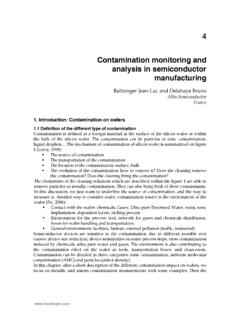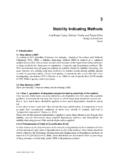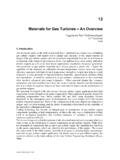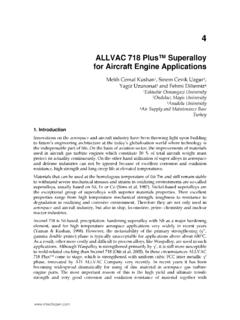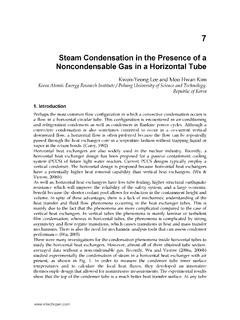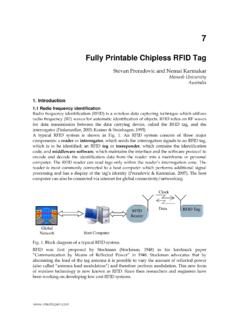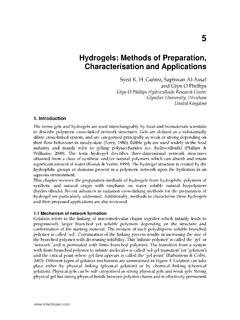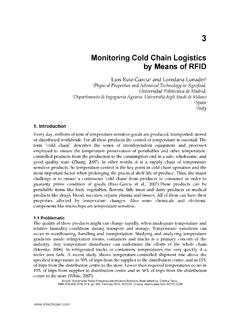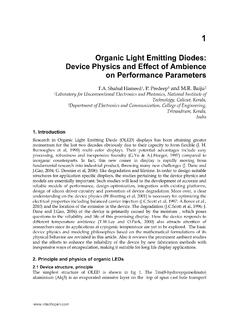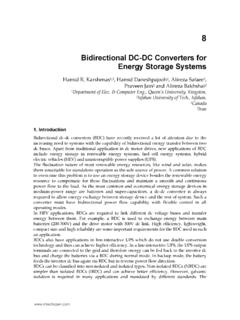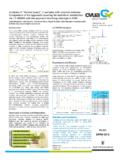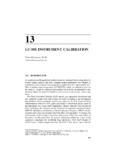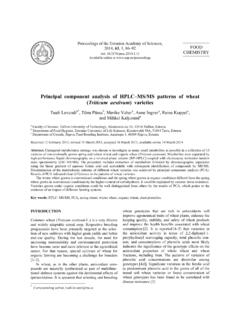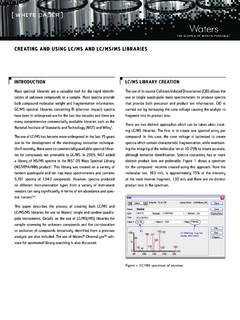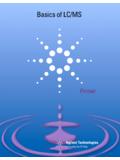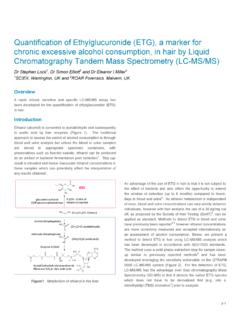Transcription of Principles and Applications of LC-MS/MS for the ...
1 20. Principles and Applications of LC-MS/MS for the quantitative bioanalysis of Analytes in Various Biological Samples Ju-Seop Kang Department of Pharmacology & Clinical Pharmacology Laboratory, College of Medicine;. Division of Molecular Therapeutics Development, Hanyang Biomedical Research Institute, Hanyang University, Seoul, South Korea 1. Introduction Standard technology for analyte detection in clinical chemistry fields rely on indirect characteristics of an analyte , its absorption capability of light, chemical reactivity or physicochemical interaction with macro-molecules as like antigen-antibody interaction. Otherwise, analytes are detected directly from molecular characteristics as molecular mass and molecular disintegration patterns in mass spectrometric method.
2 Thus, mass spectrometric technology are very attractive for the quantification of biomarkers or chemicals in the context of diagnostic procedures since those techniques can be provide higher quality of analysis of much higher specificity compared to standard technologies such as photometry or ligand-binding tests. Even if gas chromatography-mass spectrometry (GC-MS) is first introduced mass spectrometric methods to laboratory medicine about 40 years ago and provide highly specific and sensitive quantification of thermo-stable molecules below a molecular weight of about 500, application of GC-MS. method remained restricted to few specialized institution in laboratory medicine such as mainly toxicology laboratories, medical centres, and reference laboratories.
3 The handling and maintenance of GC-MS instruments is very demanding and time-consuming; sample preparation is very laborious and includes procedures of sample extraction and analyte derivatisations and long run time with a typical sample throughput of less than 50. samples per day. Over the past decade with introduction of atmospheric pressure ionization (API) techniques, liquid chromatography-mass spectrometry (LC-MS) has undergone tremendous technological improvement allowing for its Applications to endogenous components such as proteins, peptides, carbohydrates, DNA, and drugs or metabolites. Furthermore, powerful new technologies of ion-analyses (tandem MS, time- of-flight MS, ion-trap MS) substantially increased the capabilities of MS analyzers with respect to specificity and to the extent of data read out.
4 These developments suggest a more widespread use of MS techniques superior to other analytical methods in routine laboratory medicine. The aims of this chapter is to comprehensively characterize the basic Principles of mass spectrometric detection, recent development of MS, bottleneck of LC-MS method associate 442 Tandem Mass Spectrometry Applications and Principles with matrix effect, application fields of LC with tandem MS in basic and clinical laboratory fields such as drug discovery and development, drug metabolism and toxicology studies, quantification of biogenic amines, doping control, TDM and pharmacokinetic (PK) studies.
5 2. Basic Principles of mass spectrometric detection Mass spectrometry (MS) has been described as the smallest scale in the world, not because of its size of what it weighs a molecule and a microanalytical technique that can be used selectively to detect and determine the amount of a given analyte (Watson & Sparkman, 2007; Chiu & Muddiman, 2008). MS is also used to determine the elemental composition and some aspect of the molecular structure of an analyte . Unique features of MS include its capacity for direct determination of the nominal mass of an analyte , and to produce and detect fragments of the molecule that correspond to discrete groups of atoms of different elements that reveal structure features (Watson & Sparkman, 2007).
6 The tools of MS are mass spectrometers, and data are called mass spectra that can be displayed in many different ways, which allow the desired information about the analyte to be easily extracted (Watson & Sparkman, 2007). A MS is an apparatus which produces a beam of gaseous ions from a sample, sorts out the resulting mixture of ions according to their mass-to-charge ratios, and provides output signals which are measures of relative abundance of each ionic species present. MS are usually classified on the basis of how the mass separation is accomplished, but they all can be described as ion optical devices which separate ions according to their mass-to-charge (m/z) ratios by utilizing electric and/or magnetic force fields (Figure.)
7 1). The concept of MS is to form ions from a sample, to separate the ions based on their m/z ratio (this can be considered to be the same as the mass because the ion has only a single charge in most cases), and to measure the abundance of the ions. In modern MS instrumentation used in environmental analyses, all of the functions (ionization separation of the ions, rate of data acquisition, detection of the ions, and storage of the data). are under computer control. Gaseous molecules are ionized in the ion source to form molecular ions which some of that will fragment. By various processes, ions of differing m/z values pass through the mass analyzer one at a time to reach the detector.
8 When the ions strike the detector, they are converted into an electrical signal which, in turn, is converted into a digital response that can be stored by the computer (Sparkman, 2000). A mass specterometer does not directly determine mass but, determines the mass of a molecule by measuring the m/z of its ion. The knowledge of the m/z of the ions enables one to determine what is present, while the measured ion intensities answer the question of how much is present. In addition, systematic interpretation of the mass spectra provides a detailed picture of the ionization process which, in turn, may be utilized in the elucidation of molecular structures.
9 This definition of the term m/z is important to understanding of MS. It should be noted that the m/z value is a dimensionless number that is always used as an adjective, the ions with m/z 256, or the ion has an m/z value of 256. A recording of the number of ions (abundance) of a given m/z value as a function of the m/z value is a mass spectrum (Watson & Sparkman, 2007). The mass component that makes up the dimensionless m/z unit is based on an atomic scale rather than the physical scale normally considered as mass. Only ions are detected in mass specterometer and any nonionic particles that have no charge are removed from the mass spectrometer by the continuous pumping that maintains the vacuum.
10 The MS first must produce a collection of ions in the gas phase. These ions are separated according to their m/z values in a vacuum where the Principles and Applications of LC-MS/MS . for the quantitative bioanalysis of Analytes in Various Biological Samples 443. Fig. 1. Diagram of mass spectrometer system. ions cannot collide with any other forms of matter during the separation process. Ions of individual m/z values are separated and detected in order to obtain the mass spectrum. Separation of ions in an evacuated environment is mandatory. If an ion collides with neutrals in an elastic collision during ion separation process, the ion's direction of travel could be altered and ion might not reach the detector.
